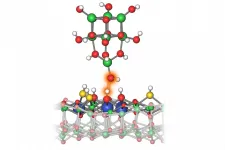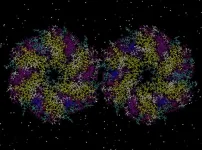How acidic are atoms?
The acidity of molecules can be easily determined, but until now it was not possible to measure this important property for atoms on a surface. With a new microscopy technique from the Vienna University of Technology (TU Wien), this has now been achieved.
2021-04-28
(Press-News.org) The degree of acidity or alkalinity of a substance is crucial for its chemical behavior. The decisive factor is the so-called proton affinity, which indicates how easily an entity accepts or releases a single proton. While it is easy to measure this for molecules, it has not been possible for surfaces. This is important because atoms on surfaces have very different proton affinities, depending on where they sit.
Researchers at TU Wien have now succeeded in making this important physical quantity experimentally accessible for the first time: Using a specially modified atomic force microscope, it is possible to study the proton affinity of individual atoms. This should help to analyze catalysts on an atomic scale. The results have been published in the scientific journal Nature.
Precision instead of average
"All previous measurements of surface acidity had one severe drawback," says Prof. Ulrike Diebold from the Institute of Applied Physics at TU Wien. "Although the surface atoms behave chemically differently, one could only ever measure the average value."
Thus it is not known which atoms contributed to chemical reactions, and to what extent, which makes it impossible to adjust the atomic scale of the surface to favor certain chemical reactions. But that is exactly what is needed, for example, when looking for more effective catalysts for hydrogen production.
"We analyzed surfaces made of indium oxide. They are particularly interesting because there are five different types of OH groups with different properties on the surface," says Margareta Wagner, who carried out these measurements in Prof. Diebold's lab.
With a special trick it was possible to study these OH groups individually: The researchers placed a single OH group at the tip of an atomic force microscope. This tip was then positioned specifically over one particular atom on the surface. A force then acts between the OH group on the tip and the OH group directly below it on the indium oxide surface, and this force depends sensitively on the distance between them.
"We vary the distance between the tip and the surface and measure how this changes the force," explains Margareta Wagner. "This gives us a characteristic force curve for each OH group on the surface of a material." The shape of this force curve provides information about how well the respective oxygen atoms on the indium oxide surface hold their protons - or how easily they will release them.
In order to obtain an actual value for the proton affinity, theoretical work was necessary. This was carried out by Bernd Meyer at the Friedrich-Alexander-University Erlangen-Nürnberg, Germany. In elaborate computer simulations it was possible to show how the force curve of the atomic force microscope can be translated in a simple and precise way into those quantities that are needed in chemistry.
Nanostructure determines the quality of catalysts
"This is quite crucial for the further development of catalysts," says Bernd Meyer. "We know that atoms of the same type behave quite differently depending on their atomic neighbors and the way they are incorporated into the surface." For example, it can make a big difference whether the surface is perfectly smooth or has steps on an atomic scale. Atoms with a smaller number of neighbors sit at such step edges, and they can potentially significantly improve or worsen chemical reactions.
"With our functionalized scanning force microscope tip, we can now precisely investigate such questions for the first time," says Ulrike Diebold. "This means that we no longer have to rely on trial and error, but can precisely understand and improve chemical properties of surfaces."
INFORMATION:
Contact
Prof. Ulrike Diebold
Institut für Angewandte Physik
Technische Universität Wien
Wiedner Hauptstraße 8, 1040 Wien
+43-1-58801-13425
ulrike.diebold@tuwien.ac.at
[Attachments] See images for this press release:

ELSE PRESS RELEASES FROM THIS DATE:
2021-04-28
COLUMBUS, Ohio - Tiny molecules called nanobodies, which can be designed to mimic antibody structures and functions, may be the key to blocking a tick-borne bacterial infection that remains out of reach of almost all antibiotics, new research suggests.
The infection is called human monocytic ehrlichiosis, and is one of the most prevalent and potentially life-threatening tick-borne diseases in the United States. The disease initially causes flu-like symptoms common to many illnesses, and in rare cases can be fatal if left untreated.
Most antibiotics can't build up ...
2021-04-28
ATLANTA--Processed diets, which are low in fiber, may initially reduce the incidence of foodborne infectious diseases such as E. coli infections, but might also increase the incidence of diseases characterized by low-grade chronic infection and inflammation such as diabetes, according to researchers in the Institute for Biomedical Sciences at Georgia State University.
This study used mice to investigate how changing from a grain-based diet to a highly processed, high-fat Western style diet impacts infection with the pathogen Citrobacter rodentium, which resembles Escherichia coli (E. coli) infections in humans. The findings are published in the journal PLOS Pathogens.
Gut microbiota, the microorganisms living in the intestine, provide a number of benefits, ...
2021-04-28
The scientific community is focusing its research into the multiple applications of Hydrogels, polymeric materials which contains a large amount of water, that have the potential to reproduce the features of biological tissues. This aspect is particularly significant in the field of regenerative medicine, which since a long time has already recognised and been using the characteristics of these materials. In order to be used effectively to replace organic tissues, hydrogels must meet two essential requirements: possessing great geometric complexity and, after suffering of a damage, being ...
2021-04-28
Researchers at the University of Bath investigating how virtual reality (VR) can help improve balance believe this technology could be a valuable tool in the prevention of falls.
As people grow older, losing balance and falling becomes more common, which increases the risk of injury and affects the person's independence.
Falls are the leading cause of non-fatal injuries in over 65-yearolds and account for over 4 million bed days per year in England alone, at an estimated cost of £2 billion.
Humans use three ways of keeping their balance: vision, proprioceptive (physical feedback from muscles and joints) and vestibular system (feedback from semi-circular canals in the ear). Of these, vision is the most important.
Traditional ways of assessing balance ...
2021-04-28
RESEARCH TRIANGLE PARK, N.C. -- New Army-funded synthetic biology research manipulated micro-compartments in cells, potentially enabling bio-manufacturing advances for medicine, protective equipment and engineering applications.
Bad bacteria can survive in extremely hostile environments -- including inside the highly acidic human stomach--thanks to their ability to sequester toxins into tiny compartments.
In a new study, published in ACS Central Science, Northwestern University researchers controlled protein assembly and built these micro-compartments into different shapes ...
2021-04-28
Boston - This year, more than 60,000 adults in the United States will be diagnosed with pancreatic cancer and, statistically, as few as 10 percent will survive five years after diagnosis, according to the American Cancer Society. Because pancreatic cancer is hidden deep within the body and often symptomless, it's frequently diagnosed after the disease has progressed too far for surgical intervention and/or has spread throughout the body. Research indicates that earlier detection of pancreatic tumors could quadruple survival rates; however, no validated and reliable tests for early detection of pancreatic cancer currently exist.
Now, researchers at the Cancer Research Institute at Beth Israel Deaconess Medical Center (BIDMC) have successfully created ...
2021-04-28
Every day, the sun ejects large amounts of a hot particle soup known as plasma toward Earth where it can disrupt telecommunications satellites and damage electrical grids. Now, scientists at the U.S. Department of Energy's (DOE) Princeton Plasma Physics Laboratory (PPPL) and Princeton University's Department of Astrophysical Sciences have made a discovery that could lead to better predictions of this space weather and help safeguard sensitive infrastructure.
The discovery comes from a new computer model that predicts the behavior of the plasma in the region above the surface of the sun known as the solar corona. The model was originally inspired by a similar model that describes the behavior of the plasma that fuels fusion reactions in doughnut-shaped fusion facilities known ...
2021-04-28
Although plants may look fairly inactive to casual observers, research into plant biology has shown that plants can send each other signals concerning threats in their local environments. These signals take the form of airborne chemicals, called volatile organic compounds (VOCs), released from one plant and detected by another, and plant biologists have found that a diverse class of chemicals called terpenoids play a major role as airborne danger signals.
Past studies have shown that soybean and lima bean plants both release terpenoid signals that activate defense-related genes in neighboring plants of the same species, and this chemically induced gene activation can help the plants protect themselves from ...
2021-04-28
It's well established that infectious disease is the greatest threat to the endangered chimpanzees made famous by the field studies of Jane Goodall at Gombe National Park in Tanzania. Now, new research led by scientists at Emory University shows that nearly half of the fecal samples from wild chimpanzees contain bacteria that is resistant to a major class of antibiotics commonly used by people in the vicinity of the park.
The journal Pathogens published the findings.
"Our results suggest that antibiotic-resistant bacteria is actually spreading from people to non-human primates by making its way into the local watershed," says Thomas Gillespie, senior author ...
2021-04-28
Rhinelander, Wis., April 28, 2021-- A research team from the USDA Forest Service and the University of Missouri has developed a new contaminant prioritization tool that has the potential to increase the effectiveness of environmental approaches to landfill clean-up.
Phytoremediation - an environmental approach in which trees and other plants are used to control leachate and treat polluted water and soil - hinges on matching the capability of different tree species with the types of contaminants present in soil and water. Identifying the worst contaminants ...
LAST 30 PRESS RELEASES:
[Press-News.org] How acidic are atoms?
The acidity of molecules can be easily determined, but until now it was not possible to measure this important property for atoms on a surface. With a new microscopy technique from the Vienna University of Technology (TU Wien), this has now been achieved.






